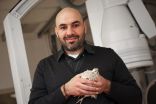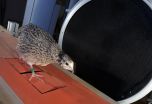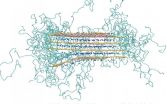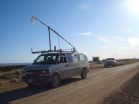INFORMATION:
Original-Publication:
Andrada E. et al.: Trunk orientation causes asymmetries in leg function in small bird terrestrial locomotion. Proceedings of the Royal Society B 2014, DOI: 10.1098/rspb.2014.1405
Contact:
Dr. Emanuel Andrada
Institute of Systematic Zoology and Evolutionary Biology with Phyletic Museum
Friedrich Schiller University Jena
Erbertstraße 1, 07743 Jena
Germany
Phone: +0049 (0)3641 949174
Email: emanuel.andrada@uni-jena.de
What quails can teach us about the gait of dinosaurs
Motion scientists and zoologists of Jena University study out the gait of birds
2014-12-09
(Press-News.org) Dinosaurs did it. Human beings and monkey do it. And even birds do it. They walk on two legs. And although humans occupy a special position amongst mammals as they have two legs, the upright gait is not reserved only for man. In the course of evolution many animals have developed the bipedal gait - the ability to walk on two legs.
"Birds are moving forward on two legs as well, although they use a completely different technique from us humans," Dr. Emanuel Andrada from the Friedrich Schiller University in Jena (Germany) says. Human beings keep their upper bodies generally in an upright position and the body's center of gravity is directly above the legs. The bodies of birds on the other hand are horizontally forward-facing, which appears to be awkward at first glance. Hence the motion scientist analyzed - together with colleagues - which effect this posture has on the movement of their legs and on their stability when they walk. The first detailed analysis of its kind has now been published by the scientists in the "Proceedings of the Royal Society B" (DOI: 10.1098/rspb.2014.1405).
To this end the team had quails walking through a high speed X-ray installation at varying speeds. While the installation monitored the movements of the animals meticulously, the scientists were able to measure the power at work in their legs. From this data, the Jena research team could develop a computer model of the whole motion sequence, which served to simulate and analyze the stability and the energy balance in connection to different gaits.
As it turned out, the birds use the so-called "grounded running" style when they move quickly - this is a running style in which at least one leg is always touching the ground. "Even when running quickly, short periods of flight phases occur only very rarely between the individual steps," Prof. Dr. Reinhard Blickhan, Chair of Motion Science at Jena University explains. But this is extremely energy consuming for the animals because the body's center of gravity lies distinctly in front of their legs - due to the horizontal posture. "The animals have to constantly balance out their own bodies in order to prevent falling forwards," says Blickhan.
But this huge effort is worthwhile as the researchers discovered with the help of their computer model. "Unlike the legs of humans which gather energy like two coil springs and use it directly to move forwards, the bird's legs work in addition like dampers or shock absorbers." In order to prevent falling forwards or to permanently accelerate their movement, the birds practically have to brake all the time. This happens while the bird leg is working like a spring damper: Energy is hereby withdrawn from the leg, but the amount of energy is the same that was invested in the hip to stabilize the trunk via the turning moment.
"This apparent wasting of energy is the price for a very stable posture during locomotion, especially on an uneven terrain," Blickhan summarizes the result of this study.
After these newly presented results, the Jena researchers anticipate interesting times ahead. They also want to test the gait of other birds with the help of the computer model they developed. And the scientists even want to analyze the locomotion of dinosaurs - the direct forebears of today's birds. "It is not clear yet how two-legged species like Allosaurus or Tyrannosaurus Rex really moved forward," says Dr. Andrada. But it is assumed by now that they also ran with their upper bodies thrust forwards horizontally - due to biomechanical advantages.
ELSE PRESS RELEASES FROM THIS DATE:
Composite materials can be designed in a supercomputer 'virtual lab'
2014-12-09
UCL scientists have shown how advanced computer simulations can be used to design new composite materials. Nanocomposites, which are widely used in industry, are revolutionary materials in which microscopic particles are dispersed through plastics. But their development until now has been largely by trial and error.
The 'virtual lab' developed using supercomputer simulations greatly improves scientists' understanding of how composite materials are built on a molecular level. They allow the properties of a new material to be predicted based simply on its structure and ...
Online students give instructors higher marks if they think instructors are men
2014-12-09
A new study shows that college students in online courses give better evaluations to instructors they think are men - even when the instructor is actually a woman.
"The ratings that students give instructors are really important, because they're used to guide higher education decisions related to hiring, promotions and tenure," says Lillian MacNell, lead author of a paper on the work and a Ph.D. student in sociology at NC State. "And if the results of these evaluations are inherently biased against women, we need to find ways to address that problem."
To address whether ...
Cancer therapy shows promise for nuclear medicine treatment
2014-12-09
Reston, Va. (December 9, 2014) - Cancer therapy can be much more effective using a new way to customize nuclear medicine treatment, researchers say in the December 2014 issue of The Journal of Nuclear Medicine. The process could also be useful for other diseases that could benefit from targeted radiation.
Targeted therapy with radiopharmaceuticals--radioactive compounds used in nuclear medicine for diagnosis or treatment--has great potential for the treatment of cancer, especially for cancer cells that have migrated from primary tumors to lymph nodes and secondary organs ...
Distraction, if consistent, does not hinder learning
2014-12-09
PROVIDENCE, R.I. [Brown University] -- Maybe distraction is not always the enemy of learning. It turns out in surprising Brown University psychology research that inconsistent distraction is the real problem. As long as our attention is as divided when we have to recall a motor skill as it was when we learned it, we'll do just fine, according to the new study.
Most learned motor tasks -- driving, playing sports or music, even walking again after injury -- occur with other things going on. Given the messiness of our existence, said lead researcher Joo-Hyun Song, assistant ...
Technology-dependent emissions of gas extraction in the US
2014-12-09
This news release is available in German.
Not all boreholes are the same. Scientists of the Karlsruhe Institute of Technology (KIT) used mobile measurement equipment to analyze gaseous compounds emitted by the extraction of oil and natural gas in the USA. For the first time, organic pollutants emitted during a fracking process were measured at a high temporal resolution. The highest values measured exceeded typical mean values in urban air by a factor of one thousand, as was reported in ACP journal.
(DOI 10.5194/acp-14-10977-2014)
Emission of trace gases by ...
CAMH discovery of novel drug target may lead to better treatment for schizophrenia
2014-12-09
TORONTO - Dec. 9, 2014 (Toronto) - Scientists at the Centre for Addiction and Mental Health (CAMH) have identified a novel drug target that could lead to the development of better antipsychotic medications.
Dr. Fang Liu, Senior Scientist in CAMH's Campbell Family Mental Health Research Institute and Professor in the Department of Psychiatry, University of Toronto, and her team published their results online in the journal Neuron.
Current treatment for patients with schizophrenia involves taking medications that block or interfere with the action of the neurotransmitter ...
UBC team finds a glitch in hummingbird hovering
2014-12-09
Hummingbirds rely on their ability to hover in order to feed off the nectar of flowers.
It's an incredible feat of flying requiring mind boggling visual processing power, but two University of British Columbia researchers found a glitch in the system, something the tiny birds are powerless to control.
The researchers put hovering hummingbirds through a virtual reality experiment that showed the birds can't control their inflight response to some visual stimuli.
In a laboratory flight arena, hummingbirds hovered around a plastic feeder while images were projected on ...
New technique could harvest more of the sun's energy
2014-12-09
As solar panels become less expensive and capable of generating more power, solar energy is becoming a more commercially viable alternative source of electricity. However, the photovoltaic cells now used to turn sunlight into electricity can only absorb and use a small fraction of that light, and that means a significant amount of solar energy goes untapped.
A new technology created by researchers from Caltech, and described in a paper published online in the October 30 issue of Science Express, represents a first step toward harnessing that lost energy.
Sunlight is ...
Ancient engravings rewrite human history
2014-12-09
An international team of scientists has discovered the earliest known engravings from human ancestors on a 400,000 year-old fossilised shell from Java.
The discovery is the earliest known example of ancient humans deliberately creating pattern.
"It rewrites human history," said Dr Stephen Munro from School of Archaeology and Anthropology at The Australian National University (ANU).
"This is the first time we have found evidence for Homo erectus behaving this way," he said.
The newly discovered engravings resemble the previously oldest-known engravings, which are ...
How pace of climate change will challenge ectotherms
2014-12-09
Animals that regulate their body temperature through the external environment may be resilient to some climate change but not keep pace with rapid change leading to potentially disastrous outcomes for biodiversity.
A study by the University of Sydney and University of Queensland showed many animals can modify the function of their cells and organs to compensate for changes in the climate and have done so in the past, but the researchers warn that the current rate of climate change will outpace animals' capacity for compensation (or acclimation).
The research has just ...
LAST 30 PRESS RELEASES:
How talking slows eye movements behind the wheel
The Ceramic Society of Japan’s Oxoate Ceramics Research Association launches new international book project
Heart-brain connection: international study reveals the role of the vagus nerve in keeping the heart young
Researchers identify Rb1 as a predictive biomarker for a new therapeutic strategy in some breast cancers
Survey reveals ethical gaps slowing AI adoption in pediatric surgery
Stimulant ADHD medications work differently than thought
AI overestimates how smart people are, according to HSE economists
HSE researchers create genome-wide map of quadruplexes
Scientists boost cell "powerhouses" to burn more calories
Automatic label checking: The missing step in making reliable medical AI
Low daily alcohol intake linked to 50% heightened mouth cancer risk in India
American Meteorological Society announces Rick Spinrad as 2026 President-Elect
Biomass-based carbon capture spotlighted in newly released global climate webinar recording
Illuminating invisible nano pollutants: advanced bioimaging tracks the full journey of emerging nanoscale contaminants in living systems
How does age affect recovery from spinal cord injury?
Novel AI tool offers prognosis for patients with head and neck cancer
Fathers’ microplastic exposure tied to their children’s metabolic problems
Research validates laboratory model for studying high-grade serous ovarian cancer
SIR 2026 delivers transformative breakthroughs in minimally invasive medicine to improve patient care
Stem Cell Reports most downloaded papers of 2025 highlight the breadth and impact of stem cell research
Oxford-led study estimates NHS spends around 3% of its primary and secondary care budget on the health impacts of heat and cold in England
A researcher’s long quest leads to a smart composite breakthrough
Urban wild bees act as “microbial sensors” of city health.
New study finds where you live affects recovery after a hip fracture
Forecasting the impact of fully automated vehicle adoption on US road traffic injuries
Alcohol-related hospitalizations from 2016 to 2022
Semaglutide and hospitalizations in patients with obesity and established cardiovascular disease
Researchers ‘listen in’ to embryo-mother interactions during implantation using a culture system replicating the womb lining
How changing your diet could help save the world
How to make AI truly scalable and reliable for real-time traffic assignment?
[Press-News.org] What quails can teach us about the gait of dinosaursMotion scientists and zoologists of Jena University study out the gait of birds






